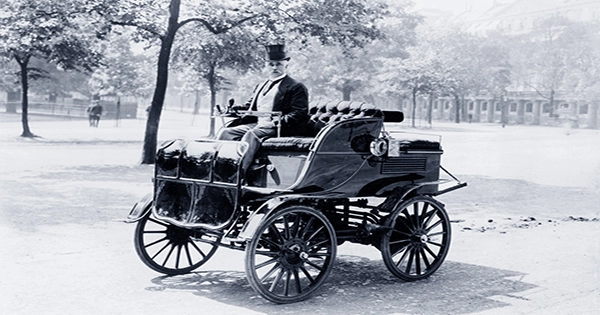There are some things in the universe that seem to have existed forever, but upon closer examination, reveal themselves to be barely old enough to vote. Consider the security at airports. A full-body scan and a TSA patdown before a flight seem not only common but also required. But if you talk to anyone old enough to have traveled before 9/11, they’ll tell you how they used to stroll up to the gate minutes before departure, carry on pretty much whatever they wanted, and only have to go through a simple metal detector. They didn’t even have to show their ID to any TSA agents because the TSA did not, in fact, exist.
The things that appear to be ultra-modern but are actually hundreds of years old are at the other extreme of the spectrum. Things include watching movies in ultra-high definition and describing things as “awesome” to express your approval. Electric automobiles fall well into the second category; they are not, as they are sometimes depicted, the future’s transportation; rather, they have a nearly 200-year history that we are only now beginning to revisit.
It’s not a typo when I say that the first model of what could be considered a “electric automobile” debuted in 1828. The UK was still in the Georgian era, Germany hadn’t been created, and Eliza Hamilton, Alexander’s wife, was still alive and well in New York’s East Village when Nyos Jedlik, a Hungarian physicist and Benedictine priest, built his tiny model automobile around his invention.

Around this time, Robert Anderson, a Scottish inventor, also developed an electric carriage that could be driven. However, it would take another few decades before any useful electric cars were put into production for a variety of reasons.
In April 1881, an engineer by the name of Gustave Trouvé made history in Paris when he rolled down the street in his most recent creation: the first electric vehicle capable of carrying people and having its own power source. It was constructed from a tricycle and a Siemens electric motor, and it was powered by the rechargeable battery, a relatively recent invention that changed the game. Electric vehicles were being developed in the UK, France, Germany, and, by 1891, the USA, within the space of a decade.
Des Moines, Iowa produced the first electric vehicle in the US, and like everything else in America, it was larger than its European competitors. It had six seats and had a top speed of 22.5 kilometers per hour (14 miles per hour). Although it wasn’t particularly advanced, it was enough to influence other auto manufacturers in the nation, which helped the industry grow.
There was the Fritchle Electric Automobile, a pioneering totally electric vehicle built in Denver in the early 1900s and powered by a 28-cell battery pack weighing between 180 and 270 kilograms (400 and 600 pounds). The fact that it could travel up to 160 kilometers (100 miles) on a single charge with an eight-horsepower motor must have astounded anyone who witnessed it. In order to demonstrate his dominance to rivals, Oliver Fritchle himself traveled 2,100 kilometers (1,300 miles) in one of the cars in 1908, traveling from Lincoln, Nebraska, to New York City.
Electric vehicles had thus far proven themselves on public roads, but they also offered other benefits over gasoline-powered vehicles, such as being cleaner, quieter, and simpler to operate. They were increasingly simple to charge as more cities electrified themselves, which added to their ease. The fact that electric ambulances and taxis were available in New York and London, as well as the fact that a driver of an electric car, Jacob German, received the first-ever speeding ticket after being caught traveling at a dizzying 19 km/h (12 mph), makes it understandable why they were so popular.
Even Henry Ford and Thomas Edison got in on the action, announcing a partnership to develop a less expensive electric automobile in the mid-1910s. However, this endeavor was ultimately unsuccessful. It wasn’t just intrepid inventors who are now lost to history who were pushing the vehicles.
Nearly one in three new vehicles in the US in 1900 was electric-powered; they outsold all other car kinds and the industry was worth more as a result. Even after a decade of industrial development that has been exponential, less than one in every twenty new automobiles are electric now.
Why did the public opinion of electric cars deteriorate so quickly? There are several of them. Ironically, their simplicity of use eventually worked against them, as people began to perceive them as a feminine objects, better suited for women visiting friends than for a muscular American guy with aspirations of conquering the wilderness.
But much more so, it became clear that shortsightedness and abuse of power were the real issues. Liquid gasoline simply produced more energy per unit mass than a lead-acid battery could, according to engineers and drivers. In the meanwhile, it was unlikely that anyone living outside of a metropolis would have access to electricity; any lengthy drive in an electric car would conjure up images of being stuck in some sleepy town with a dead battery and no way to recharge it.
On the other side, gasoline was strong and readily available. It may have appeared impossible that the Texas Oil Boom could ever end because liquid petroleum was still in its infancy. The market for electric vehicles gradually declined to the point of near extinction, while gas-powered cars began to rule the planet.
Electric cars didn’t start to gain favor again until the 1990s, a century after their peak in popularity. States began enacting laws governing car emissions as the world was only beginning to recognize the issue of climate change. More significantly, the heavy, unwieldy, and ineffective lead batteries that powered early electric vehicles could eventually be replaced thanks to the invention of the lithium-ion battery in 1985 and its commercialization in 1991.
The EV1 was the first mass-produced modern electric vehicle from a significant automaker, and it was introduced by General Motors in 1996. A year later, Honda unveiled the EV Plus, the first vehicle to do away with lead-acid batteries. However, things didn’t truly take off until 2003, when engineers Martin Eberhard and Marc Tarpenning founded Tesla Motors, a manufacturer of electric sports cars.
After the release of the Tesla Roadster, the first mass-produced all-electric vehicle to be highway legal, Bob Lutz, vice chairman of General Motors, told The New Yorker in 2009, “All the geniuses here at General Motors kept saying lithium-ion technology is 10 years away, and Toyota agreed with us – and boom, along comes Tesla.”
“I asked, ‘How come this little company in California, led by men with no experience in the auto industry, can do this and we can’t?'”
He recalled, “The crowbar that was used to free the traffic congestion was that one.
Since then, the industry has grown steadily; today, it is difficult to find a car manufacturer that doesn’t offer an all-electric model. We travel with electric buses, we may fly in electric aircraft, and in the desert, electric speedsters compete in airborne drag races.
Even then, electric cars are still a long way from the crazed popularity they experienced more than a century ago. An electric car was almost twice as likely to be found in the wild during its peak in the 1900s as a gas-powered one. Less than one in every hundred cars on the road today is an electric vehicle.
However, things are evolving. By 2035, California will no longer allow the sale of new gas-powered vehicles, and other states are likely to follow.
To achieve the declared objective of net-zero emissions by 2050 set forth by the Biden administration, such actions are probably essential. Electric vehicles should be just as affordable to purchase in five years as gas-powered ones, and some fairly creative ideas are being proposed to make the environmental alternative even greener.
Will electric vehicles ever regain their former level of popularity? Time will only tell. The real question, though, maybe whether we can truly afford for battery-powered vehicles to not be the norm given their environmental advantages over the currently prevalent fossil fuel equivalents.
















